Sinatra! Deep Cuts: "Same Old Saturday Night"
Another Man of Mystery in the Musical Life of Frank Sinatra
If you were to stop me on the street and ask me what my single favorite track by Frank Sinatra is, I might likely say “I Wish I Were In Love Again” from A Swingin’ Affair (1957) or the 1955 single, “Same Old Saturday Night.” (Of course, asking me what I think the greatest Sinatra track is might yield a different answer.)
In the 2018 edition of my book, Sinatra! The Song is You, I wrote the following:
“Same Old Saturday Night” is perhaps the most extreme example of Sinatra’s skills at mood-mixing: the melody is joyful and euphoric, like a happy-go-lucky love song, but the lyric is, if not totally down, exceedingly melancholy; it’s a song about being lonely and missing someone. He sounds both defeated and triumphant at the same time, even enjoying his state of abject loneliness. He expresses both in the timbre of his voice and even uses rhythm as an emotional signifier: for most of the song, he phrases solidly on the beat, with the optimism of a little kid reciting a nursery rhyme (and I’m particularly enamored of the way he turns the beat around at the end of the bridge on the second chorus, “How I wish you’d lift the phone”). Then, at the end, following a tag that only appears in the second chorus (and that he probably suggested himself: “Only your face / Can help me erase . . .”) he starts to relax his hold on the time, the mood then shifts from staccato to legato, and the singer starts to reveal the amazing storehouse of passion that he’s been saving up for the person he’s been singing to. It’s enough to expect any other singer to offer us either sadness or elation, but no one matched Sinatra at delivering both at the same time, enough to turn even a minor song, virtually never sung by anyone else, into a pop classic, a complex web of emotions that transcends anything else in the realm of popular song interpretation and invites comparison to Verdi, Hart, Porter, or Sondheim.
“I Wish I Were In Love Again” is a classic song by Richard Rodgers and Lorenz Hart, one of the most celebrated teams in American music. “Same Old Saturday Night” has one famous co-author, Sammy Cahn, and another who is completely obscure, Frank Reardon.
The song was published by Sinatra’s firm, Barton Music, located in the Brill Building at 1619 Broadway and 49th Street. For years I harbored a personal theory - ultimately a fantasy - that “Frank Reardon” was secretly a pseudonym for Jimmy Van Heusen. This was the period when Van Heusen was winding down his long partnership with Johnny Burke, and he wrote a few songs with other lyricists that were published under various noms-de-publishing. The most famous of these was “Somewhere Along the Way,” credited to Sammy Gallop and “Kurt Adams” (Van Heusen) which was a hit for Nat King Cole in 1952 and recorded by Sinatra in 1961 on Point of No Return. Another was “I Could Have Told You” by Carl Sigman and “Arthur Williams” (Van Heusen), which was a significant early Sinatra / Riddle / Capitol single in 1953.
So it’s not completely wacko to think that “Same Old Saturday Night” might also be the work of Van Heusen under a pseudonym, especially when it’s Sammy Cahn writing the lyrics. However, there’s no mention of the song in the Van Heusen publishing files - maintained by his grand-nephew Brook Babcock, whereas there is a paper trail that establishes both “Somewhere Along the Way” and “I Could Have Told You” as the work of Van Heusen.
And it turns out that there was a Frank Reardon; he is credited with writing about 50 songs with his usual partner, Ernest Schweikert. Of these, two were recorded by artists close to Sinatra:
“This Is Heaven to Me” was the very last song that Billie Holiday recorded for Decca, cut at a 1950 session with arranger-conductor Gordon Jenkins and issued as the flip side of “God Bless The Child.” (Gordon MacRae also recorded the song for Capitol Records.)
The other is “All Dressed Up And No Place To Go,” recorded by Sammy Davis, Jr., as a Decca single in 1956. (The song is from Rumple, about which more presently.)
There are many more songs by Frank Reardon & Ernest Schweikert listed on the BMI / ASCAP Songview database, but only a few have notable recordings attached. In 1951, Gordon MacRae recorded a song “On A Sunday At Coney Island” which is listed as by Reardon & Schweikert on the Songview page, but on youTube, two entirely different composers are credited:
Not to overlook this comedy classic by our friend, the late Larry Storch:
And not only that, the team of Reardon & Schweikert had one Broadway show, a 1957 flop titled Rumple with a book by Irving Phillips based on his 1957 play, which ran for 45 performances at the Alvin Theater. It’s been thus described by Dan Dietz in The Complete Book of 1950s Broadway Musicals: “The plot of Rumple seemed a natural for a musical comedy, for here was a potentially magical, tongue-in-cheek look at the dilemma of two cartoon characters Rumple (Eddie Foy) and Anna (Barbara Perry) who will be condemned to Oblivia (the final home for former comic-strip people and last year’s calendar girls) unless they can convince their human artist Nelson Crandall (Stephen Douglass) to get busy and back to the drawing board.”
There was no official cast album, but some of the songs were recorded - “How Do You Say Goodbye” by The Four Aces and “In Times Like These” as recorded by another of Sinatra’s favorite singers, Sylvia Syms - and there is a short playlist on YouTube, which includes the Sammy Davis, Jr. track as well as Carmen McRae doing “Coax Me.” “In Times Like These” sounds precisely like it was written to be a Sinatra-Riddle single; since no vocalist is credited on the youTube link, I suspect it’s Reardon himself. (There’s even a ring-a-ding reference; this was just around the time Sinatra began using that catchphrase, famously in “I Won’t Dance” and elsewhere.)
But here’s what might be even more surprising: My indefatigable researcher Jordan Taylor came up with yet further proof that there really was a Frank Reardon in that it turns out he was also a recording artist. He was, in fact, a singer, who must be regarded as one of the very earliest crooners to pattern himself after Sinatra.
Around the time of “This Is Heaven to Me,” he recorded at least one single for Signature Records, Bob Thiele’s label, accompanied by Ray Bloch, who was already conducting for The Ed Sullivan Show (then still being called The Toast of The Town), and at least one more for Coral Records, a Decca subsidiary, arranged by Don Costa - who would famously go on to a big career as a publisher and arranger-producer. Of the four songs, at least three were co-written by Reardon.
https://archive.org/search?query=creator%3A%22FRANK+REARDON%22
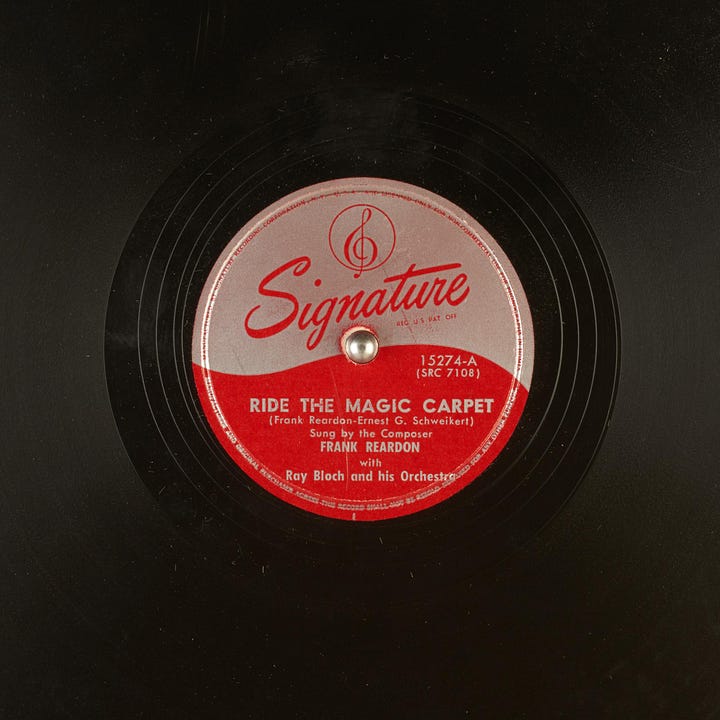
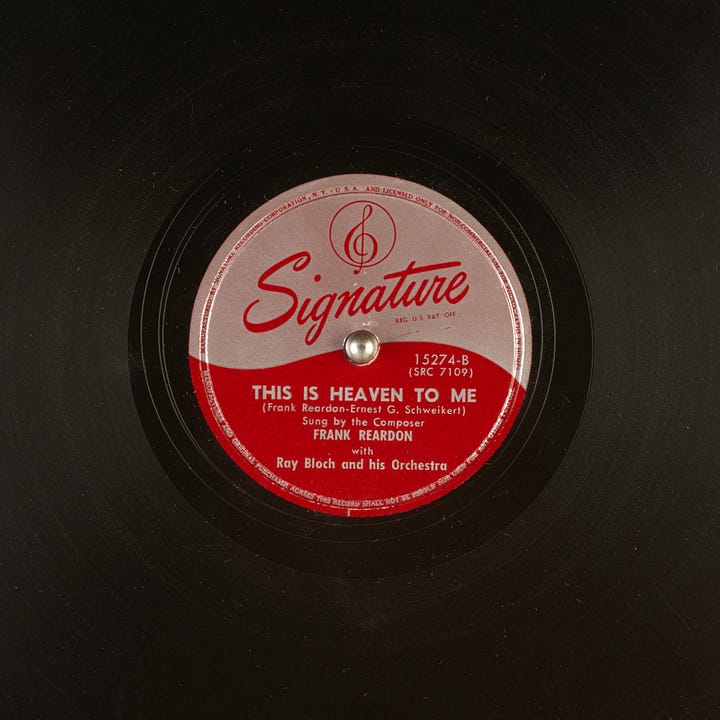
Ironically, or perhaps not, the most memorable of the four is the one with the dumbest title, "Shalaree Shalaroo." The name suggests a novelty song, but it turns out to be a reasonably well-constructed romantic waltz with a novelty title. It’s well written and well sung if not exactly unforgettable, even though it’s never explained precisely what is meant by "Shalaree Shalaroo."
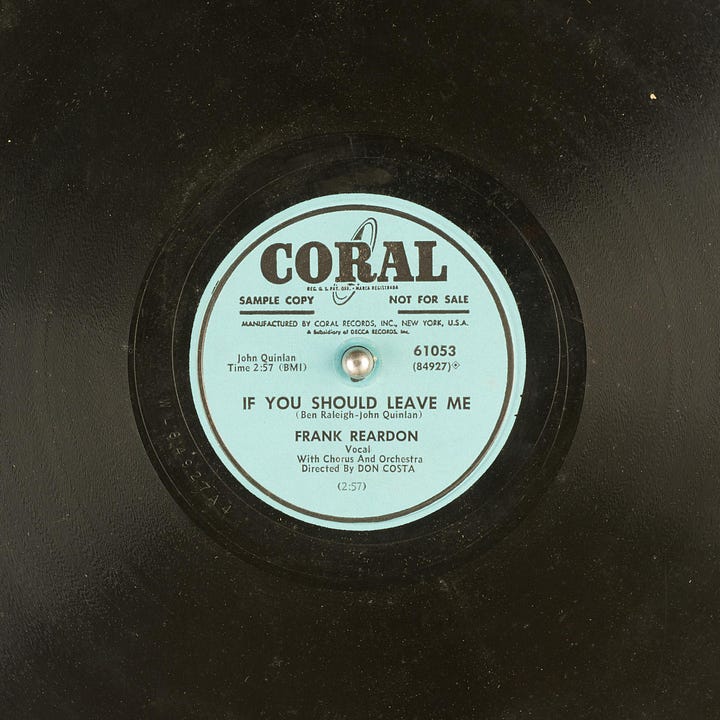
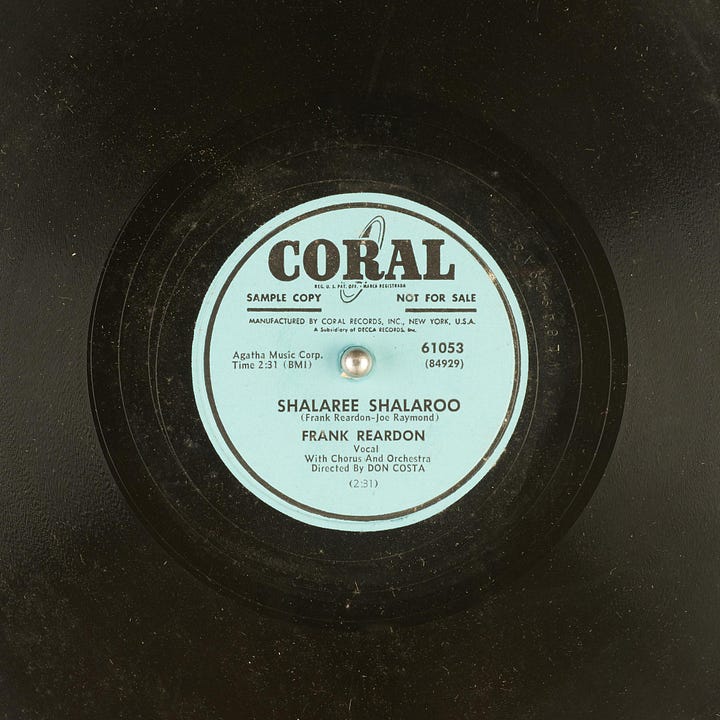
After “Same Old Saturday Night” (1955) and Rumple (1957), the trail kind of goes cold on Reardon; there’s a brief Billboard clip from 1962 establishing that he and Schweikert were currently “pacted” to publisher and bandleader George Paxton’s music firm. But that’s about it.
This new information probably raises more questions than it solves. How did Reardon connect with Sinatra, Sammy Cahn, and Barton Music? Why was he writing music for this one song, which would come to be his most famous, when all the other songs he worked on credit him as the lyricist? And yes, there’s the extra tag at the end of the second chorus, which extends the song for dramatic purposes. - a device Sinatra employs on “From Here to Eternity,” “Why Should I Cry Over You,” and “The Tender Trap” and other songs. We know, from the testimony of Bob Wells, “Eternity” lyricist, that these were usually Sinatra’s idea, something he asked writers to include when doing a song for him. I could have asked Sammy, but I didn’t think of it on the occasions when I spoke with him, and in his later years Sammy was infamous for only wanting to talk about his top tunes and avoiding any mention of any song that wasn’t a major hit or a standard.
If anybody can answer any of these questions, how I wish you’d lift the phone and let me know, hey.
Very Special thanks to the fabulous Ms. Elizabeth Zimmer, for expert proofreading of this page, and scanning for typos, mistakes, and other assorted boo-boos!
Sing! Sing! Sing! : My tagline is, “Celebrating the great jazz - and jazz-adjacent - singers, as well as the composers, lyricists, arrangers, soloists, and sidemen, who help to make them great.”
A production of KSDS heard Saturdays at 10:00 AM Pacific; 1:00PM Eastern.
To listen to KSDS via the internet (current and recent shows are available for streaming.) click here.
The whole series is also listenable on Podbean.com, click here.
SING! SING! SING!
May 4, 2024: BING CROSBY SINGS RICHARD RODGERS
May 11, 2024: LOUIS PRIMA: THE LIFE, THE LEGEND, THE LINGUINI!
SLOUCHING TOWARDS BIRDLAND is a subStack newsletter by Will Friedwald. The best way to support my work is with a paid subscription, for which I am asking either $5 a month or $50 per year. Thank you for considering. (Thanks as always to Beth Naji & Arlen Schumer for special graphics.) Word up, peace out, go forth and sin no more! (And always remember: “A man is born, but he’s no good no how, without a song.”)
Note to friends: a lot of you respond to my SubStack posts here directly to me via eMail. It’s actually a lot more beneficial to me if you go to the SubStack web page and put your responses down as a “comment.” This helps me “drive traffic” and all that other social media stuff. If you look a tiny bit down from this text, you will see three buttons, one of which is “comment.” Just hit that one, hey. Thanks!







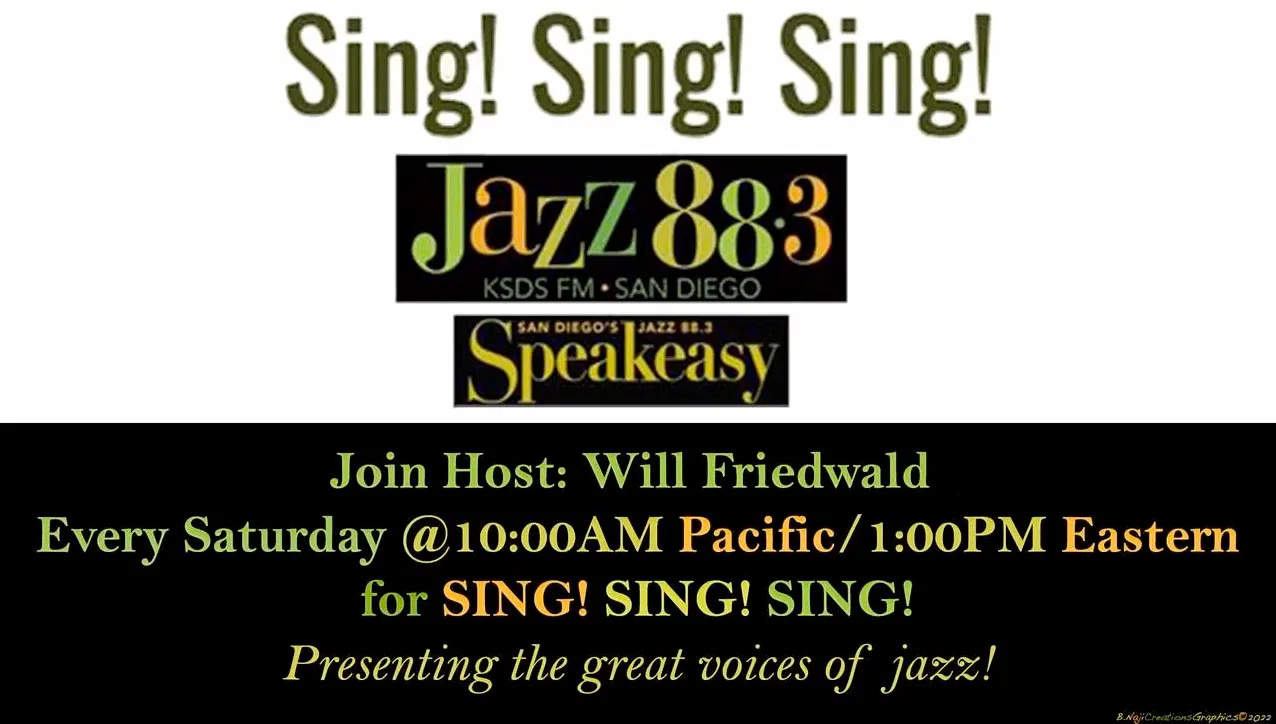
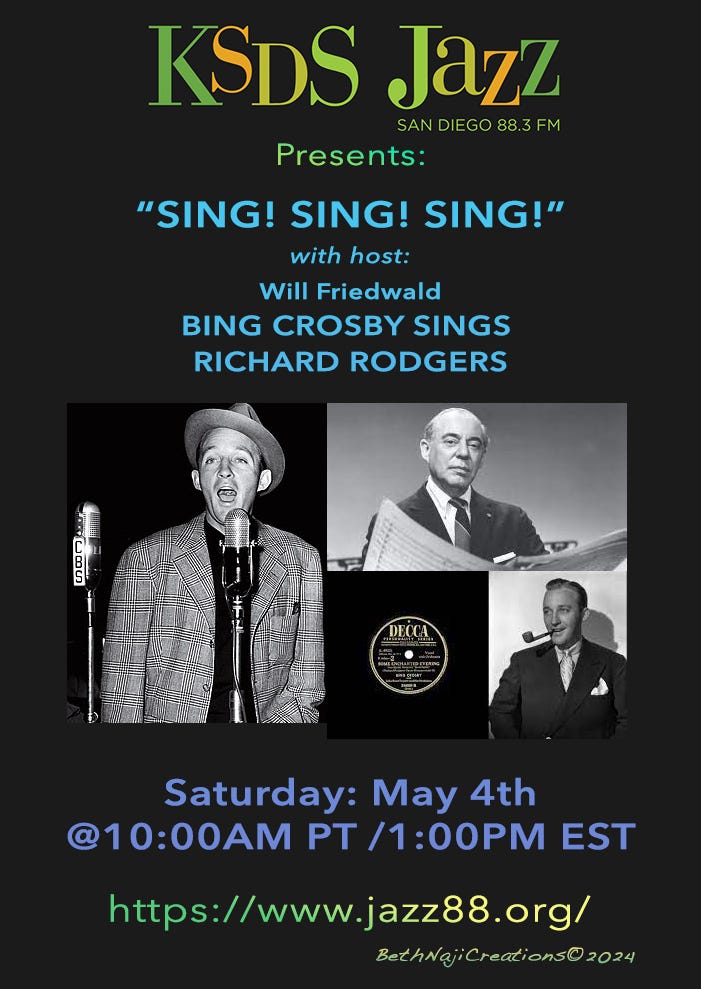
A fascinating read (as always)!
"Rumple" has a very intriguing plot; it was a shame it didn't work out.